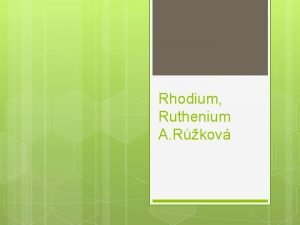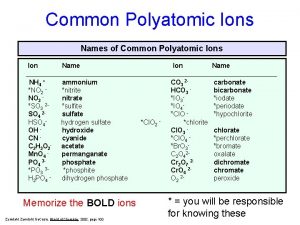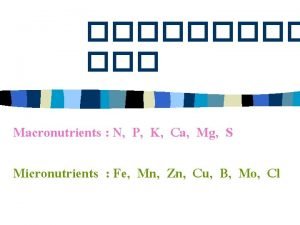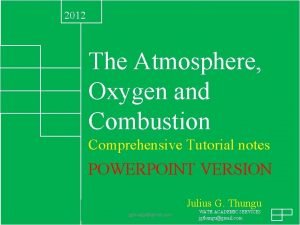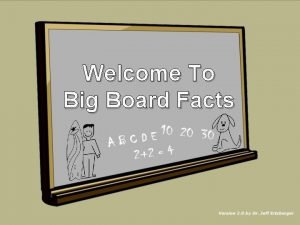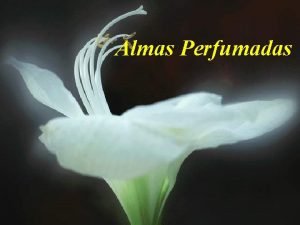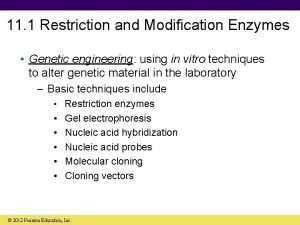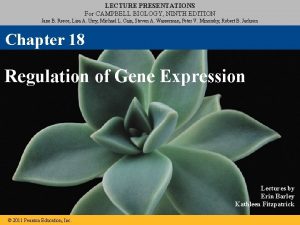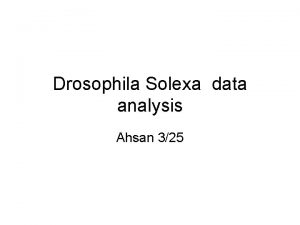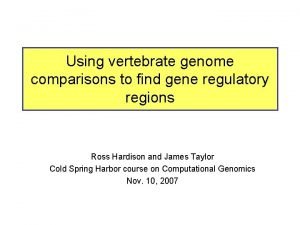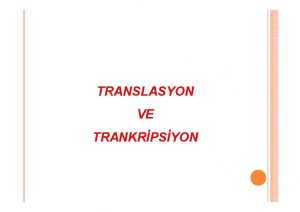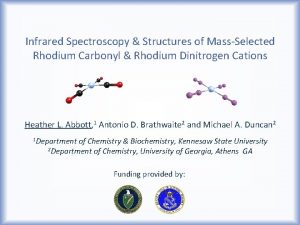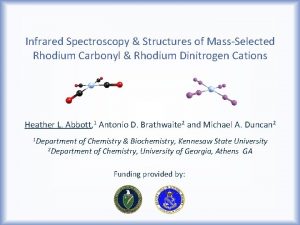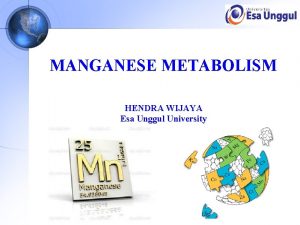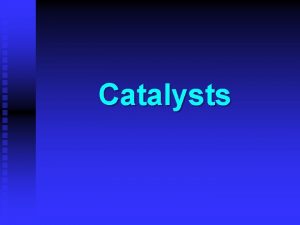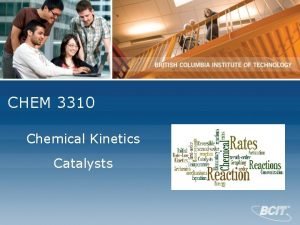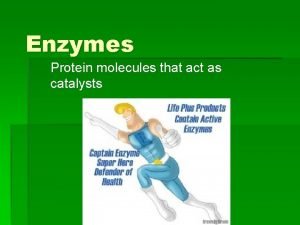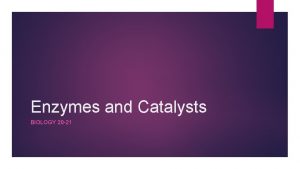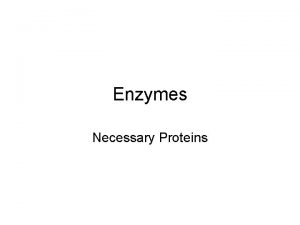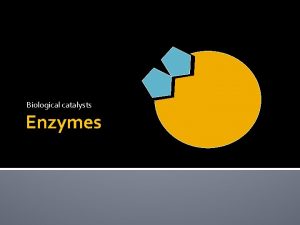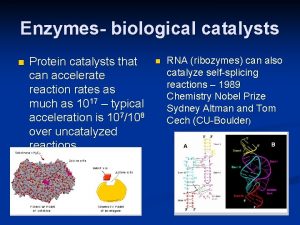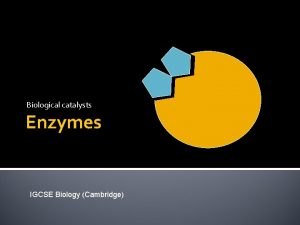TEM Study of Rhodium Catalysts with Manganese Promoter

















- Slides: 17

TEM Study of Rhodium Catalysts with Manganese Promoter Adrian Merritt NSF REU program at UIC, 7/29/2010 1

Outline I. Research Objectives and Methods II. Sample Characterization III. Particle Size Results IV. Research Conclusion V. Future Work NSF REU program at UIC, 7/29/2010 UIC Physics 2

Research Objectives �The core objective is to better understand how the manganese promoter affects the rhodium catalyst performance �Some current possibilities are: • Particle size • Oxide species • Changes to interfacial interaction • Formation of surface oxides NSF REU program at UIC, 7/29/2010 UIC Physics 3

� Due to the de Broglie wavelength, electron microscopes can have a fundamentally finer resolution than light microscopes � Electrons passing through the sample are scattered by various mechanisms � Spatial, mass/thickness and analytical information is available from the scattered electrons TEM Image from Transmission Electron Microscopy, B. Williams and C. Carter, volume IV NSF REU program at UIC, 7/29/2010 UIC Physics 4

Fischer-Tropsch (and related) Processes � Invented by Franz Fischer and Hans Tropsch � Utilizes syngas to produce hydrocarbon products (methane, ethanol, diesel and gasoline fuels) � Syngas is a mixture of CO and H 2, which can be produced from coal gasification, natural gas, or biogas, and is used as the base feedstock for the process � In all cases though, the reaction relies upon the proper catalysts for selectivity and efficiency NSF REU program at UIC, 7/29/2010 UIC Physics 5

Rhodium Catalyst, Manganese Promoter � Rhodium is a useful catalyst for the FT process as it lies at an intermediate mass level and so works to create ethanol for use as an alternative fuel source � Manganese acts as a promoter, which changes the effects of a catalyst without being a catalyst itself � Manganese improves the selectivity and overall efficiency of rhodium catalysts for the FT process � E. g. from T. Feltes: 1% Mn loading on 3% Rh on Si. O 2 support raises CO conversion ten fold and increases ethanol selectivity from 0. 0% to 9. 2% Image from The Selective Adsorption of a Manganese Promoter Over Supported CO Hydrogenation Catalysts, Theresa E. Feltes, 2010 NSF REU program at UIC, 7/29/2010 UIC Physics 6

Holey Carbon Films � Carbon film on copper support grid � d = 3 mm � Allows deposition of catalyst particles and easy viewing � Powdered samples are prepared by dry impregnation (DI) or strong electrostatic adsorption (SEA) NSF REU program at UIC, 7/29/2010 UIC Physics 7

Final Sample �Final sample has many medium-sized clusters of silica particles �Best (most useful) clusters are those overhanging an edge (reduces impact of Cfilm) NSF REU program at UIC, 7/29/2010 UIC Physics 8

Current Samples � � Rhodium on silica, 3% loading by DI with 1% manganese Calcination at 350° C for 4 hours in air Reduction (when applicable) at 300° C for 2 hours under H 2 Images from The Study of Heterogeneous Catalysts by Highflow Resolution Transmission Electron Microscopy, A. Datye & D. Smith, Catalyst Review, 1992 NSF REU program at UIC, 7/29/2010 UIC Physics 9

Imaging Samples � Typical magnification is x 300 k � Use diffraction contrast imaging to differentiate rhodium particles (crystalline) from the silica support (amorphous) NSF REU program at UIC, 7/29/2010 UIC Physics 10

Particle Sizes (Unpromoted) Averages: 3. 12 nm vs. 3. 08 nm Standard deviations: 0. 80 nm vs. 0. 83 nm The same (within experimental limits)! 25 Rh. Ox (6. 18. 2010) Rh (Reduced) (6. 21. 2010) 25 20 20 Frequency 15 10 5 5 0 0. 5 1 1. 5 2 2. 5 3 3. 5 4 4. 5 5 5. 5 >5. 5 Particle Size (nm) NSF REU program at UIC, 7/29/2010 1 1. 5 2 2. 5 3 3. 5 4 4. 5 Particle Size (nm) 5 5. 5 >5. 5 UIC Physics 11

Particle Sizes (Promoted) Averages: 2. 26 nm vs. 2. 44 nm Standard deviations: 0. 54 nm vs. 0. 67 nm Rh. Ox + Mn (7. 7. 2010) 45 40 40 35 35 30 30 Frequency 45 25 20 Rh+Mn (Reduced) (7. 7. 2010) 25 20 15 15 10 10 5 5 0 0 0. 5 1 1. 5 2 2. 5 3 3. 5 4 4. 5 Particle Size (nm) 5 5. 5 >5. 5 NSF REU program at UIC, 7/29/2010 0. 5 1 1. 5 2 2. 5 3 3. 5 4 4. 5 Particle Size (nm) 5 5. 5 >5. 5 UIC Physics 12

Particle Sizes (Promoted, in situ Heating) 35 30 30 25 25 20 20 Frequency Averages: 2. 55 nm vs. 2. 43 nm Standard deviations: 0. 91 nm vs. 0. 69 nm Heated at 300° C for 2 hours, then allowed to cool 35 Rh+Mn (Heated) (7. 19. 2010) 15 15 10 10 5 5 0 Rh+Mn (Cooled) (7. 9. 2010) 0 0. 5 1 1. 5 2 2. 5 3 3. 5 4 4. 5 Particle Size (nm) 5 5. 5 >5. 5 0. 5 NSF REU program at UIC, 7/29/2010 1 1. 5 2 2. 5 3 3. 5 4 4. 5 Particle Size (nm) 5 5. 5 >5. 5 UIC Physics 13

Summary Sample Average Particle Size (nm) Standard Deviation (nm) Rh. Ox (unreduced) 3. 12 0. 80 Rh 3. 08 0. 83 Rh+Mn Ox (unreduced) 2. 26 0. 54 Rh+Mn 2. 44 0. 67 Rh+Mn (in situ heating) 2. 55 0. 91 Rh+Mn (after cooling) 2. 43 0. 67 Averages not different enough to cause all phenomena observed in catalysts with a promoter NSF REU program at UIC, 7/29/2010 UIC Physics 14

Future Work � Catalyst particle size has been ruled out � Next step is JEOL JEM-2010 F work • Better resolution through Z-contrast imaging • EELS setup � EELS allows changes in electronic structure to be characterized � Together, structure allows better characterization of NSF REU program at UIC, 7/29/2010 UIC Physics 15

FEFF Counts (Arb. units) Experimental vs. Theoretical 530 Rh 2 O 3 O K-Edge FEFF � University of Washington ab initio program for simulation EELS spectra � Full multiple scattering simulation � Preparation for JEM-2010 F EELS work, distinguishing rhodium oxide species Rh. O 2 O K-Edge FEFF Rh 2 O 3 O K-Edge Gatan 535 540 545 550 555 560 Energy (e. V) 565 570 575 NSF REU program at UIC, 7/29/2010 580 UIC Physics 16

Acknowledgements �National Science Foundation and Department of Defense for funding, EECNSF Grant # 0755115 �Professors Takoudis and Jursich as REU organizers �Professor Robert Klie as PI �Yuan Zhao as mentor �Ke-Bin Low for TEM training and aid �The RRC for its support in TEM work NSF REU program at UIC, 7/29/2010 UIC Physics 17
 Prokaryotic and eukaryotic venn diagram
Prokaryotic and eukaryotic venn diagram Relational escalation catalysts
Relational escalation catalysts Rhodium ruthenium
Rhodium ruthenium Auric nitride formula
Auric nitride formula Mg s
Mg s Laboratory preparation of oxygen
Laboratory preparation of oxygen Hexacarbon decahydride formula
Hexacarbon decahydride formula Tem gente que tem cheiro
Tem gente que tem cheiro Tem gente que tem cheiro de passarinho quando canta
Tem gente que tem cheiro de passarinho quando canta Quem tem ouvidos ouça quem tem olhos veja
Quem tem ouvidos ouça quem tem olhos veja Quem encontrou amigo encontrou um tesouro
Quem encontrou amigo encontrou um tesouro Promoter is a person who,
Promoter is a person who, Lac promoter
Lac promoter Enhancer promoter
Enhancer promoter Tugas promoter
Tugas promoter Enhancer promoter
Enhancer promoter Exon intron promoter
Exon intron promoter Replikasyon transkripsiyon translasyon
Replikasyon transkripsiyon translasyon


